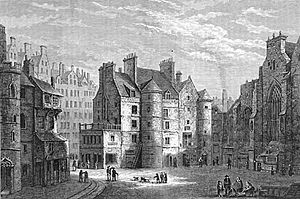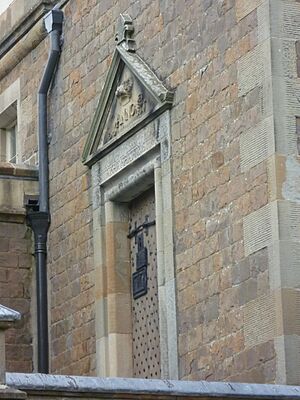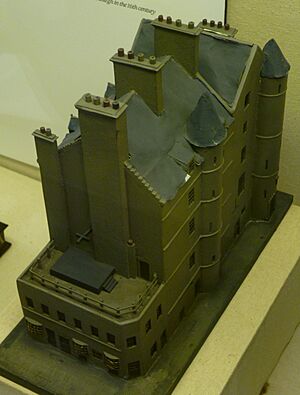Old Tolbooth, Edinburgh facts for kids
Quick facts for kids Old Tolbooth, Edinburgh |
|
|---|---|
 |
|
| Former names | Pretorium Burgi |
| General information | |
| Type | Municipal building |
| Architectural style | Scottish Medieval |
| Location | High Street |
| Town or city | Edinburgh |
| Country | Scotland |
| Coordinates | 55°56′57.95″N 3°11′30.21″W / 55.9494306°N 3.1917250°W |
| Construction started | 1386 |
| Completed | c. 1400 |
| Renovated | 1561 |
| Demolished | 1817 |
The Old Tolbooth was a very important building in Edinburgh, Scotland, for over 400 years. This old building was in the Old Town, near St Giles' Cathedral on the High Street. It was first built in the 1300s.
A "tolbooth" was a special kind of building in Scottish towns. It was like a town hall, a court, and a jail all in one! The Old Tolbooth in Edinburgh was used by the town council, for early meetings of the Scottish Parliament, and for court cases. It also served as the main jail, where people were held and sometimes punished. From 1785, it was a place where serious punishments happened in public. The Old Tolbooth was rebuilt and fixed up many times before it was finally taken down in 1817.
Contents
History of the Old Tolbooth
Records show there was an earlier building called a pretorium (an old word for a tolbooth) in Edinburgh as early as 1368. Edinburgh had been burned down several times by English kings in the 1300s. So, the city needed a lot of rebuilding.
In 1386, King Robert II gave Edinburgh a special paper called a charter. This charter gave the town a piece of land in the market place. The land was about 60 feet long and 30 feet wide. The king said they could build houses and buildings there to make the town look better and for their own use. This new building was meant to be a "Belhouse," which was another name for the town's main office.
We don't have records of when the building was finished. But on October 3, 1403, the town records first mention the "Pretorio burgi" – the Tolbooth of Edinburgh. Later, in 1438, the Scottish Parliament started using this building for their meetings. By 1451, the word "tolbooth" was officially used in records.
A "belhouse" often had a tall tower with a bell. This bell was rung to help manage the town's business and daily life. In Edinburgh, the "pretorium" and "belhouse" were basically the same thing: the town's main offices.
The land for the Tolbooth was very close to St Giles' Cathedral. When the Tolbooth was built, it made the street much narrower at that spot. Today, you can see a pattern of stones on the ground called the Heart of Midlothian. This marks where the entrance to the original building used to be.

By the time Mary, Queen of Scots was queen, the Tolbooth was in bad shape. In 1561, the queen ordered it to be torn down and rebuilt. Because of this, the town council used part of St Giles' Cathedral for Parliament and court meetings. They also built a new building for the town council. Both of these new places were sometimes called the "New Tolbooth," which could be confusing!
In 1571, the tower of the Old Tolbooth was taken down. In 1639, the Scottish Parliament moved to a brand new building called Parliament Hall. The Old Tolbooth continued to be used as a prison by the town council. In 1811, the council moved their offices to the Edinburgh City Chambers.
The Old Tolbooth stayed a prison and a place for public punishments until it was finally taken down in 1817.
The famous writer Sir Walter Scott wrote a lot about the Old Tolbooth in his book The Heart of Midlothian. This book was published in 1818, just a year after the building was demolished. It tells a story set during the Porteous Riots of 1736. Sir Walter Scott even got the old prison door from the Tolbooth and put it into his own home, Abbotsford House, near Melrose.
Famous People Held in the Old Tolbooth
Many well-known people were held in the Old Tolbooth over the years, including:
- Thomas Aikenhead
- Archibald Campbell, 1st Marquis of Argyll
- Robert Balfour, 5th Lord Balfour of Burleigh
- Deacon Brodie
- James Douglas, 4th Earl of Morton
- John Fian
- James Graham, 1st Marquis of Montrose
- Alexander Home, 3rd Lord Home
- Archibald Johnston, Lord Warriston
- Alexander Peden
- Captain John Porteous
- Agnes Sampson
- Major Weir
Other Tolbooths in Edinburgh
Edinburgh has grown a lot, so now there are other tolbooths or places where tolbooths used to be. Some still exist, like the Canongate Tolbooth on the lower part of the Royal Mile, the South Queensferry Tolbooth, and the tolbooth in Dean Village.
Leith, which is Edinburgh's port, also had its own tolbooth. It was located on a street still called Tolbooth Wynd. The areas of Broughton and Restalrig also had their own tolbooths.
| Preceded by Church of the Friars Preachers of Blessed Virgin and Saint Dominic |
Home of the Parliament of Scotland 1438–1563 |
Succeeded by St Giles' Cathedral |
Images for kids





